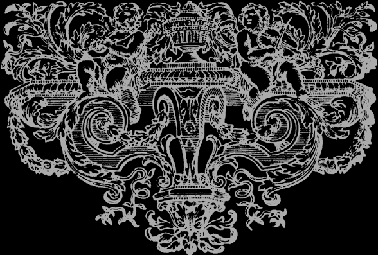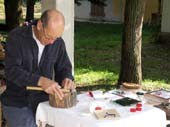
N E W 5 - O C T A V E H A R P S I C H O R D S
I N T H E N E A P O L I T A N S T Y L E
The way I make the rosettes on Grant and Graziano's Neapolitan harpsichords
by Johnny Bell
Grant and I drew the patterns using AutoCAD and produced printouts at an accurate one-to-one scale. These are what I use as the first template - thereafter I eyeball it. The patterns are an amalgam of various designs that we have seen over the years and are accurate in style to the period and region that we desire. They are, however, not slavish copies of any one particular rose. We try to garner the best elements of what we have seen and incorporate them into our designs.
There are some
of these designs on
this website
and pictures of me doing the work. We have used an
all-wooden rosette
in the first four of Grant and Graziano's harpsichords that was made by Willie
Hendry, a colleague and ex-student of Grant's. There is a
section on this site
written by Willie about how he made these rosettes. Mine, however, are not all
wood but are of wood as a top layer and then several layers of parchment
underneath.
I bought some Italian leather workers' punches for the medium-sized
and smaller holes that need to be cut - they come in graduated sizes from 1mm to
6mm in half millimetre steps. They are cone-shaped on the outside so are not
good for punching wood because the cutter, as it sinks into the material, gets
fatter and therefore forces the material open which in wood splits it (and in
parchment and vellum makes for a slightly sloping side to the hole - this is not
unpleasant and can produce a glimpse of a lower layer very economically). So
for the large holes I asked a friend of ours to make some outside-straight-sided
cutters with the sloping edge on the inside - they are really good for cutting
large circles in wood. For the tiny holes - used almost universally for cutting
in parchment and vellum I use broken drill bits that have had the end flattened,
and for complicated shapes I use drill bits ground to the shape of the desired
hole.
One needs to harden the steel of the home-made punches by heating to a cherry-red heat and then suddenly cooling them. For the hand-cutting of straight and curved lines, I find that a Bard-Parker scalpel blade 10A is ideal for all cutting needs - they come un-sterile in packs of five for minimal cost - I change it every time I start work and often halfway through as the tips tend to get blunt or snap off. I used to grind them down but it's not worth it they are so cheap and sharp and fine and firm. Anything than the 10A tends to be too long and therefore too flexible and therefore unstable.
Good luck! When I have ironed out the glitches in the designs (one needs to make several trials to get the pattern to run smoothly and the impossibilities and infelicities removed), I find the work very satisfying and when it goes well the effect is lovely.
Return to the previous section

